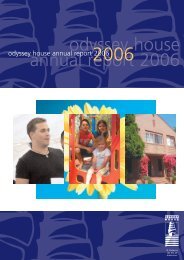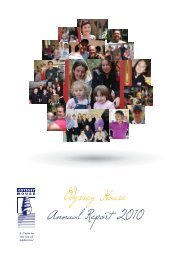ATS Literature Review, Consultations & Trial - Odyssey House
ATS Literature Review, Consultations & Trial - Odyssey House
ATS Literature Review, Consultations & Trial - Odyssey House
You also want an ePaper? Increase the reach of your titles
YUMPU automatically turns print PDFs into web optimized ePapers that Google loves.
Amphetamine‐Type Stimulants: Development of a Treatment Protocol<br />
People with mental illness are much more vulnerable to the adverse effects of a whole range of<br />
drugs. Hence people with schizophrenia who use cannabis (for example) have:<br />
• higher rates of admission to hospital;<br />
• higher doses of medication;<br />
• higher rates of unemployment, suicide, and imprisonment; and<br />
• more severe mental health problems.<br />
Illicit drugs and alcohol can also interfere with the way in which prescribed medications work, and<br />
increase the risk of side effects. In particular, alcohol can affect the rate of metabolism and cannabis<br />
use may result in the person’s prescribed medication needing to be increased to provide a<br />
therapeutic benefit.<br />
It is generally accepted that rates of substance use are higher among those with mental illness<br />
compared to those without, and that people who use illicit drugs are more likely to experience<br />
mental illness than non‐users. Results from the National Drug Strategy <strong>House</strong>hold Survey 2004<br />
(AIHW, 2007) show that almost two in five persons who used an illicit drug in the past month<br />
reported high or very high levels of psychological distress. The most common mental health<br />
problems experienced by people who use illicit drugs are anxiety and mood disorders. Of particular<br />
concern is the association between <strong>ATS</strong>, cannabis and mental health problems, particularly in young<br />
people.<br />
While it cannot be implied that cannabis use causes schizophrenia in people who would otherwise<br />
not have developed it, there is good epidemiological evidence of a significant association between<br />
cannabis use and the risk of meeting criteria for schizophrenia (Degenhardt & Hall, 2002). There is<br />
also good evidence to suggest that cannabis use is a more important risk factor for psychotic<br />
symptoms among those with a family history of, or pre‐existing, schizophrenia (Degenhardt, et.al.,<br />
2007). Additionally, there is concern regarding the association between cannabis and <strong>ATS</strong>, especially<br />
methamphetamine, with increased admissions of young people to acute psychiatric facilities with<br />
apparent psychosis (Degenhardt, et.al., 2007).<br />
Survey data from the 2005 report, Australian Secondary School Students’ Use of Over‐the‐Counter<br />
and Illicit Substances, showed that 95% of secondary school students had never used<br />
amphetamines, including methamphetamines and ice (White & Hayman, 2006). Amongst all<br />
students surveyed around 1% indicated that they had used amphetamines regularly in the year prior<br />
to the survey. Although the data shows a low usage rate in school students, with increasing age, the<br />
proportion of students to have ever used amphetamines increases (3% of 12‐year‐olds; 8% of 16‐<br />
year‐olds and 7% of 15‐ and 17‐year‐olds). Therefore, the pattern of amphetamine type substance<br />
use in young people suggests a low level of experimentation with the drug and with very few<br />
reporting recent use (White & Hayman, 2006). However, illicit and licit drug use in young people is<br />
associated with serious road crashes, problems with drug misuses and dependence and future<br />
polydrug use (Nicholas & Shoobridge, 2005).<br />
1.7. Maternal and foetal health<br />
Methamphetamine use in pregnancy has been associated with increased risk of miscarriage,<br />
premature birth and problems in the newborn period. Babies born to mothers who are<br />
methamphetamine users may also exhibit signs of withdrawal (OTIS, 2005). This includes jitteriness<br />
and trouble sleeping and eating (OTIS, 2005). There have also been cases of birth defects, including<br />
heart defects and cleft lip/palate, in exposed babies, but researchers do not yet know whether the<br />
drug contributed to these defects (Smith, LaGasse, Derauf, Grant, et.al., 2006).<br />
Page 28 © Lynne Magor‐Blatch & James A. Pitts: <strong>Odyssey</strong> <strong>House</strong> McGrath Foundation 2008‐2009








